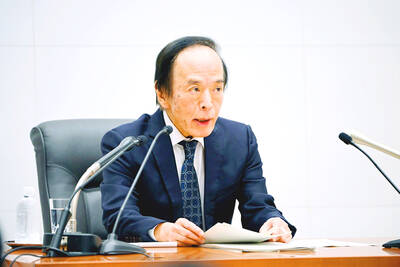Despite a semiconductor shortage, global PC shipments in the first quarter of this year increased 32 percent from a year earlier, preliminary data from research firm Gartner Inc showed.
Shipments in the January-to-March period totaled 69.87 million units from 52.93 million units a year earlier, Gartner said in a report on Monday last week.
The quarterly increase in shipments marked the fastest annual growth since it began tracking the PC market in 2000, Gartner said.

Photo courtesy of Acer Inc
“This growth should be viewed in the context of two unique factors: comparisons against a pandemic-constrained market and the current global semiconductor shortage,” Gartner research director Mikako Kitagawa said in a news release.
“Without the shipment chaos of early 2020, this quarter’s growth might have been lower. However, semiconductor shortages are now adversely affecting the supply chain once again, with shipment lead times for some PCs extending out as far as four months,” Kitagawa said.
PC demand is to remain strong, even after stay-at-home restrictions ease as countries gain control over COVID-19 outbreaks, but vendors and suppliers should avoid creating excess inventory, Gartner said.
In particular, growing PC demand in the educational segment — after the COVID-19 pandemic forced many schools to turn to distance learning — has prompted many vendors to build up their Chromebook inventory, it said.
Chromebook shipments in the first quarter more than tripled from a year earlier, Gartner said, adding that the growth was primarily driven by educational institutions in North America.
An analysis released on April 9 by International Data Corp (IDC) showed that global PC shipments in the first quarter increased 55.2 percent to 83.98 million units year-on-year.
While seasonal factors, component shortages and logistical issues caused the figure to fall 8 percent from the fourth quarter of last year, the sequential decline was the smallest since the first quarter of 2012, when PC shipments declined 7.5 percent sequentially, IDC said in a statement.
The rival researchers use different calculations to measure the market — Gartner defines PCs as desktops, notebooks and ultramobile premium devices, while IDC categorizes them as desktops, notebooks and workstations.
“Unfulfilled demand from the past year has carried forward into the first quarter and additional demand brought on by the pandemic has also continued to drive volume,” IDC research manager Jitesh Ubrani said in the statement.
Other factors — such as growth in gaming, the need for higher-performance notebooks in the enterprise market and an increase in demand for touchscreens within the education segment — helped to drive PC demand in the first quarter, the research firm said.
However, the ongoing semiconductor shortage is delaying vendors’ ability to restock inventory and fill customer orders, IDC mobile device trackers program vice president Ryan Reith said in the statement.
“All three segments — business, education and consumer — are experiencing demand that we didn’t expect to happen, regardless of many countries beginning their ‘opening up’ process,” Reith said.
“Component shortages will likely be a topic of conversation for the majority of 2021, but the more important question should be what PC demand will look like in two to three years,” Reith added.
In both the Gartner and IDC reports, Lenovo Group Ltd (聯想) was the No. 1 vendor in the first quarter, followed by HP Inc and Dell Technologies Inc, with Apple Inc and Acer Inc (宏碁) rounding out the top five.

Taiwan Semiconductor Manufacturing Co (TSMC, 台積電) last week recorded an increase in the number of shareholders to the highest in almost eight months, despite its share price falling 3.38 percent from the previous week, Taiwan Stock Exchange data released on Saturday showed. As of Friday, TSMC had 1.88 million shareholders, the most since the week of April 25 and an increase of 31,870 from the previous week, the data showed. The number of shareholders jumped despite a drop of NT$50 (US$1.59), or 3.38 percent, in TSMC’s share price from a week earlier to NT$1,430, as investors took profits from their earlier gains

In a high-security Shenzhen laboratory, Chinese scientists have built what Washington has spent years trying to prevent: a prototype of a machine capable of producing the cutting-edge semiconductor chips that power artificial intelligence (AI), smartphones and weapons central to Western military dominance, Reuters has learned. Completed early this year and undergoing testing, the prototype fills nearly an entire factory floor. It was built by a team of former engineers from Dutch semiconductor giant ASML who reverse-engineered the company’s extreme ultraviolet lithography (EUV) machines, according to two people with knowledge of the project. EUV machines sit at the heart of a technological Cold

TAIWAN VALUE CHAIN: Foxtron is to fully own Luxgen following the transaction and it plans to launch a new electric model, the Foxtron Bria, in Taiwan next year Yulon Motor Co (裕隆汽車) yesterday said that its board of directors approved the disposal of its electric vehicle (EV) unit, Luxgen Motor Co (納智捷汽車), to Foxtron Vehicle Technologies Co (鴻華先進) for NT$787.6 million (US$24.98 million). Foxtron, a half-half joint venture between Yulon affiliate Hua-Chuang Automobile Information Technical Center Co (華創車電) and Hon Hai Precision Industry Co (鴻海精密), expects to wrap up the deal in the first quarter of next year. Foxtron would fully own Luxgen following the transaction, including five car distributing companies, outlets and all employees. The deal is subject to the approval of the Fair Trade Commission, Foxtron said. “Foxtron will be

INFLATION CONSIDERATION: The BOJ governor said that it would ‘keep making appropriate decisions’ and would adjust depending on the economy and prices The Bank of Japan (BOJ) yesterday raised its benchmark interest rate to the highest in 30 years and said more increases are in the pipeline if conditions allow, in a sign of growing conviction that it can attain the stable inflation target it has pursued for more than a decade. Bank of Japan Governor Kazuo Ueda’s policy board increased the rate by 0.2 percentage points to 0.75 percent, in a unanimous decision, the bank said in a statement. The central bank cited the rising likelihood of its economic outlook being realized. The rate change was expected by all 50 economists surveyed by Bloomberg. The